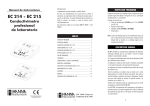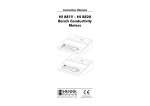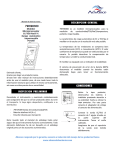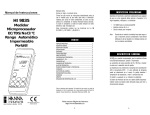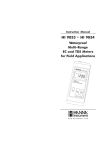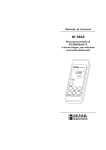Download Caple CM460 Instruction manual
Transcript
Instruction Manual EC214 EC215 - EC215R Bench Conductivity Meters http://www.hannainst.com These Instruments are in Compliance with the CE Directives Dear Customer, Thank you for choosing a Hanna Instruments Product. Please read this instruction manual carefully before using the instrument. This manual will provide you with all the necessary information for the correct use of the instrument, as well as a precise idea of its versatility in a wide range of applications. These instruments are in compliance with directives. TABLE OF CONTENTS PRELIMINARY EXAMINATION ............................................................ 3 PRELIMINARY EXAMINATION Remove the instrument from the packing material and examine it carefully to make sure that no damage has occurred during shipping. If there is any damage, notify your dealer. Each meter is supplied complete with: • Conductivity Probe (HI76300 for EC 214, HI76303 for EC 215 and EC 215R); • Instruction Manual; • 12VDC adapter (HI710005 or HI710006); • Dust cover. Note: Save all packing material until you are sure that the instrument functions correctly. All defective items must be returned in the original packing with the supplied accessories. GENERAL DESCRIPTION .................................................................... 3 FUNCTIONAL DESCRIPTION EC 214 ................................................... 4 SPECIFICATIONS EC 214 .................................................................. 5 FUNCTIONAL DESCRIPTION EC 215 ................................................... 6 SPECIFICATIONS EC 215 .................................................................. 7 OPERATIONAL GUIDE ....................................................................... 8 CALIBRATION ................................................................................ 10 CONDUCTIVITY VS. TEMPERATURE CHART ......................................... 13 DETERMINATION OF THE TEMPERATURE COEFFICIENT OF A SOLUTION (EC 215 & EC 215R) ........................... 14 PROBE MAINTENANCE ................................................................... 15 ACCESSORIES ............................................................................... 16 WARRANTY ................................................................................... 18 CE DECLARATION OF CONFORMITY .................................................. 19 2 GENERAL DESCRIPTION EC 214 and EC 215 are digital bench-top multirange conductivity meters designed for simplicity of use in measuring electrical conductivity in liquids. Four ranges of conductivity measurements are provided to cover every application from deionized water to brine. The calibration is made simple through the easy-to-operate front panel knob for slope adjustment. The conductivity probe does not require re-calibration when switching from one range to another. The probe is made of glass with 4 platinum rings that are corrosion resistant. It is also suitable for measuring conductivity of liquids in small sample sizes, and comes with a 1 m (3.3') cable. The temperature effect can be compensated through a knob on the front panel of EC 214. With EC 215, the 4-ring probe has a built-in temperature sensor that automatically compensates for temperature changes in the liquid tested. The temperature coefficient can be adjusted from 0 to 2.5% through a knob on the front panel. It is also available a model with recorder output feature: EC 215R. 3 FUNCTIONAL DESCRIPTION EC 214 SPECIFICATIONS EC 214 Range Resolution Accuracy (@20°C / 68°F) Typical EMC Deviation Calibration Temperature Compensation Probe Power Supply Environment 1) 2) 3) 4) 5) 6) 7) Liquid Crystal Display (LCD) Conductivity calibration knob 8) 9) 10) 11) Temperature setting knob for manual compensation ON/OFF switch Power adapter socket Probe connector Dimensions Weight 0.0 to 199.9 µS/cm 0 to 1999 µS/cm 0.00 to 19.99 mS/cm 0.0 to 199.9 mS/cm 0.1 µS/cm 1 µS/cm 0.01 mS/cm 0.1 mS/cm ±1% Full Scale (excluding probe error) ±1% Full Scale Manual single point through front knob Manual from 0 to 50 C with ß fixed at 2%/ C HI 76300 platinum 4-ring conductivity probe with 1m (3.3') cable (included) 12 VDC adapter (HI710005 or HI710006 included) 0 to 50 C (32 to 122 F); 0-95% RH non-condensing 240x182x74 mm (9.4x7.1x2.9") 1.0 Kg (2.3 lb.) 199.9 µS key, to select the range 0.0 to 199.9µS/cm 19.99 mS key, to select the range 0.00 to 19.99 mS/cm 199.9 mS key, to select the range 0.0 to 199.9mS/cm 1999 µS key, to select the range 0 to 1999µS/cm COND/ C key, to select conductivity reading or temperature setting for manual compensation 4 5 FUNCTIONAL DESCRIPTION EC 215 SPECIFICATIONS EC 215 Range Resolution Accuracy (@20°C / 68°F) Typical EMC Deviation Calibration Temperature Compensation Probe (included) Analog Output (EC 215R only) 1) Liquid Crystal Display (LCD) 2) Conductivity calibration knob 3) 199.9 µS key, to select the range 0.0 to 199.9µS/cm 4) 19.99 mS key, to select the range 0.00 to 19.99 mS/cm 5) 199.9 mS key, to select the range 0.0 to 199.9mS/cm 6) 1999 µS key, to select the range 0 to 1999µS/cm 7) Temperature Coefficient setting knob 8) ON/OFF switch 9) Power adapter socket 10) Probe connector 11) Analog Output (EC 215R only) 6 Analog Output Accuracy Analog Output Resolution Power Supply Environment Dimensions Weight 0.0 to 199.9 µS/cm 0 to 1999 µS/cm 0.00 to 19.99 mS/cm 0.0 to 199.9 mS/cm 0.1 µS/cm 1 µS/cm 0.01 mS/cm 0.1 mS/cm ±1% Full Scale (excluding probe error) ±1% Full Scale Manual at single point, through front knob Automatic from 0 to 50 C with adjustable β from 0 to 2.5%/ C HI 76303 platinum 4-ring conductivity probe with temperature sensor and 1m (3.3') cable 0 to 5VCC not isolated analog output - 20mA max Range Output 0.0 to 199.9µS/cm 0 to 5 VCC 0 to 1999µS/cm 0 to 5 VCC 0.00 to 19.99mS/cm 0 to 5 VCC 0.0 to 199.9mS/cm 0 to 5 VCC 0.1% of maximum displayed value (EC 215R only) ±2.5 mV (EC 215R only) included 12 VDC power adapter (included included) 0 to 50 C (32 to 122 F); 0-95% RH non-condensing 240x182x74 mm (9.4x7.1x2.9") 1.0 Kg (2.3 lb.) 7 OPERATIONAL GUIDE Power connection Plug the 12VDC adapter (HI710005 or HI710006) into the power supply socket (#10 on page 4; #9 on page 6). Note: make sure the main line is protected by a fuse. Probe connection Connect the conductivity probe to the socket provided (#11 on page 4; #10 on page 6). Note: Make sure that the instrument has been calibrated before taking conductivity measurements (see calibration paragraph). Note: If possible, use plastic beakers to minimize EMC interferences. TAKING CONDUCTIVITY MEASUREMENTS WITH EC 214 • switch the instrument on by pressing the ON/OFF key. • Immerse the probe in the solution submerging the holes of the sleeve (0.5 cm below). Tap the probe lightly on the bottom of the beaker to remove any air bubbles trapped inside the sleeve. Take the temperature of the solution with a CHECKTEMP or a glass thermometer. • Press the “COND/ C” key to select temperature setting. • Adjust the “TEMPERATURE” knob to display the temperature of the solution on the LCD. Note: If the display shows "1", there is an over-range condition. Select the next higher range. • Allow a few minutes for the reading to stabilize. The LCD will display the temperature compensated conductivity reading. TAKING CONDUCTIVITY MEASUREMENTS WITH EC 215 • switch the instrument on by pressing the ON/OFF key. • Immerse the probe in the solution submerging the holes of the sleeve (0.5 cm below). Tap the probe lightly on the bottom of the beaker to remove any air bubbles trapped inside the sleeve. • Adjust the "TEMPERATURE COEFFICIENT" knob to the temperature coefficient value of the solution (see determination of the temperature coefficient of a solution paragraph). • Select the appropriate conductivity range. Note: If the display shows "1", there is an over-range condition. Select the next higher range. • Allow a few minutes for the reading to stabilize. The LCD will display the temperature compensated conductivity reading. • Press the “COND/ C” key to select conductivity reading. • Select the appropriate conductivity range. 8 9 PROCEDURE FOR EC 214: 0 703 HI If you are measuring in the mS ranges, calibrate the meter using HI7030 (or HI8030) conductivity solution (12.88 mS @ 25 C) or HI7034 (or HI8034) conductivity solution (80 mS @ 25 C). For the µS ranges, use HI7031 (or HI8031) conductivity solution (1413 µS @25 C) when calibrating in the range from 0 to 1999 µS or HI7033 (or HI8033) conductivity solution (84 µS @ 25 C) when calibrating in the range from 0 to 199.9 µS. Choose a solution with a conductivity value close to the solution to be measured. Rinse the probe thoroughly in distilled water. This is to minimize contamination of the calibration solution and secure higher accuracy. When possible, use plastic beakers to minimize any EMC interferences. • Pour a small quantity of the conductivity solution, e.g. HI7030 or HI8030 (12.88 mS/cm @ 25 C), into a plastic beaker. • Immerse the probe in the solution submerging the holes of the sleeve (0.5 cm below). Tap the probe lightly on the bottom of the beaker to remove any air bubbles trapped inside the sleeve. Take the temperature of the solution with a CHECKTEMP or a glass thermometer. • Press the “COND/ C” key to select temperature setting. • Adjust the “TEMPERATURE” knob to display the temperature of the solution on the LCD. 10 • All subsequent measurements will be referenced to 25 C (77 F). • To reference the measurements to 20 C (68 F), adjust the “CALIBRATION” knob to read (on the LCD) the value of the buffer solution at 20 C (68 F), e.g. 11.67 mS/cm. See conductivity vs. temperature chart. • Calibration is now complete and the instrument is ready for use. 0 INITIAL PREPARATION 7 03 The instrument should be re-calibrated at least once a month, or when the probe is changed. • Press the “COND/ C” key to select conductivity reading and select the appropriate range: "199.9 µS" for HI7033/HI8033, "1999µS" for HI7031/HI8031, "19.99 mS" for HI7030/HI8030, "199.9 mS" for HI7034/HI8034. Note: If the display shows "1", there is an over-range condition. Select the next higher range. • Allow a few minutes for the reading to stabilize and adjust the “CALIBRATION” knob to read (on the LCD) the value of the buffer solution at 25 C (77 F), e.g. 12.88 mS/cm. PROCEDURE FOR EC 215: HI CALIBRATION • Pour a small quantity of the conductivity solution, e.g. HI7030 or HI8030 (12.88 mS/cm @ 25 C), into a plastic beaker. • Immerse the probe in the solution submerging the holes of the sleeve (0.5 cm below). Tap the probe lightly on the bottom of the beaker to remove any air bubbles trapped inside the sleeve. • Adjust the "TEMPERATURE COEFFICIENT" knob to 2%/ C. 11 • Select the appropriate range: "199.9 µS" for HI7033/HI8033, "1999µS" for HI7031/HI8031, "19.99 mS" for HI7030/HI8030, "199.9 mS" for HI7034/HI8034. Note: If the display shows "1", there is an over-range condition. Select the next higher range. • Allow a few minutes for the reading to stabilize and adjust the “CALIBRATION” knob to read (on the LCD) the value of the buffer solution at 25 C (77 F),e.g. 12.88 mS/cm. CONDUCTIVITY VERSUS TEMPERATURE CHART The conductivity of an aqueous solution is the measure of its ability to carry an electrical current by means of ionic motion. The conductivity invariably increases with increasing temperature. It is affected by the type and number of ions in the solution and by the viscosity of the solution itself. Both parameters are temperature dependent. The dependency of conductivity on temperature is expressed as a relative change per degree Celsius at a particular temperature, commonly as percent per C. Since a small difference in temperature causes a large change in conductivity, the readings are usually normalized at 25 C. C • All subsequent measurements will be referenced to 25 C (77 F). • To reference the measurements to 20 C (68 F), adjust the “CALIBRATION” knob to read (on the LCD) the value of the buffer solution at 20 C (68 F), e.g. 11.67 mS/cm. See conductivity vs. temperature chart. • Calibration is now complete and the instrument is ready for use. 0 5 10 15 16 17 18 19 20 21 22 23 24 25 26 27 28 29 30 31 F 32 41 50 59 60.8 62.6 64.4 66.2 68 69.8 71.6 73.4 75.2 77 78.8 80.6 82.4 84.2 86 87.8 HI 7030 HI 8030 HI 7031 HI 8031 HI 7033 HI 8033 HI 7034 HI 8034 HI 7035 HI 8035 (µS/cm) (µS/cm) (µS/cm) (µS/cm) (µS/cm) 7150 8220 9330 10480 10720 10950 11190 11430 11670 11910 12150 12390 12640 12880 13130 13370 13620 13870 14120 14370 776 896 1020 1147 1173 1199 1225 1251 1278 1305 1332 1359 1386 1413 1440 1467 1494 1521 1548 1575 64 65 67 68 70 71 73 74 76 78 79 81 82 84 86 87 89 90 92 94 48300 53500 59600 65400 67200 68500 69800 71300 72400 74000 75200 76500 78300 80000 81300 83000 84900 86300 88200 90000 65400 74100 83200 92500 94400 96300 98200 100200 102100 104000 105900 107900 109800 111800 113800 115700 117700 119700 121800 123900 HI 7039 HI 8039 (µS/cm) 2760 3180 3615 4063 4155 4245 4337 4429 4523 4617 4711 4805 4902 5000 5096 5190 5286 5383 5479 5575 EC 214 manually compensates for temperature differences with a fixed ß at 2%. EC 215 automatically compensates for temperature differences with a built-in circuitry. A knob is provided to adjust the temperature coefficient manually from 0% (without compensation) to 2.5% per degree Celsius. 12 13 DETERMINATION OF THE TEMPERATURE COEFFICIENT OF A SOLUTION (EC 215 & EC 215R) • Immerse the probe into a sample of the solution and adjust the “TEMPERATURE COEFFICIENT” knob to 0% (i.e. no compensation). • Condition the sample and probe at 25 C and note the conductivity reading C25. • Condition the sample and probe to a temperature t C which is approximately 5 C to 10 C different from 25 C and note the conductivity reading Ct. • The temperature coefficient ß of the solution is calculated with the formula: (Ct - C25) ß = 100 x --------------------------(t - 25) x C25 PROBE MAINTENANCE Rinse the probe with tap water after every series of measurements. If a more thorough cleaning is required, remove the sleeve and clean the probe with a cloth or a nonabrasive detergent. After cleaning the probe, re-calibrate the instrument. The four ring platinum probe body is in glass. For this reason great care while handling the probe must be taken. The above procedure is suitable for determining the temperature coefficient in the laboratory where the temperature of the solution can be determined and controlled. If this is not possible, e.g. during onsite measurements, the following procedure should be used: • Immerse the probe into the test solution and turn the “TEMPERATURE COEFFICIENT” knob to 0% (no compensation). • Allow the conductivity reading to stabilize (the reading should not change by more than ±0.2 mS within 1 minute) and record the value, C. • Repeat the procedure with the temperature of the solution changed by more than 10 C. Wait for the conductivity reading to stabilize. • Adjust the “TEMPERATURE COEFFICIENT” knob until the display reads the value C as recorded earlier. • The value indicated by the knob is the temperature coefficient of the solution. 14 15 ACCESSORIES CONDUCTIVITY BUFFER SOLUTIONS: HI 7030L HI 7030M HI 7031L HI 7031M HI 7033L HI 7033M HI 7034L HI 7034M HI 7035L HI 7035M HI 7039L HI 7039M 12880 µS/cm (µmho/cm), 460mL 12880 µS/cm (µmho/cm), 230mL 1413 µS/cm (µmho/cm), 460mL 1413 µS/cm (µmho/cm), 230mL 84 µS/cm (µmho/cm), 460 mL 84 µS/cm (µmho/cm), 230 mL 80000 µS/cm (µmho/cm), 460mL 80000 µS/cm (µmho/cm), 230mL 111800 µS/cm (µmho/cm), 460mL 111800 µS/cm (µmho/cm), 230mL 5000 µS/cm (µmho/cm), 460mL 5000 µS/cm (µmho/cm), 230mL OTHER ACCESSORIES: CHECKTEMPC HI710005 HI710006 Electronic thermometer (range: -50.0 to 150.0 C) Voltage adapter from 115VAC to 12VDC Voltage adapter from 230VAC to 12VDC HI 7400011 HI 740036 HI 740034 HI 740134 HI 76405 Base for bench meters 100mL plastic beakers (6 pcs) Cap for 100mL beakers (6 pcs) Dust cover Electrode holder CONDUCTIVITY BUFFER SOLUTIONS IN FDA APPROVED BOTTLES: HI 8030L HI 8031L HI 8033L HI 8034L HI 8035L HI 8039L 12880 µS/cm (µmho/cm), 460 mL 1413 µS/cm (µmho/cm), 460 mL 84 µS/cm (µmho/cm), 460 mL 80000 µS/cm (µmho/cm), 460 mL 111800 µS/cm (µmho/cm), 460 mL 5000 µS/cm (µmho/cm), 460 mL ELECTRODE CLEANING SOLUTIONS HI 7061M HI 7061L General Cleaning Sol., 230 mL General Cleaning Sol., 460 mL ELECTRODE CLEANING SOLUTIONS IN FDA APPROVED BOTTLES HI 8061M HI 8061L General Cleaning Sol., 230 mL General Cleaning Sol., 460 mL CONDUCTIVITY PROBES: HI 76300 HI 76303 platinum 4-ring conductivity probe with 1m (3.3') cable (for EC214). platinum 4-ring conductivity probe with temperature sensor and 1m (3.3') cable (for EC215). 16 17 WARRANTY CE DECLARATION OF CONFORMITY All Hanna Instruments meters are guaranteed for two years against defects in workmanship and materials when used for their intended purpose and maintained according to instructions. The electrodes and the probes are guaranteed for a period of six months. This warranty is limited to repair or replacement free of charge. Damage due to accident, misuse, tampering or lack of prescribed maintenance are not covered. If service is required, contact the dealer from whom you purchased the instrument. If under warranty, report the model number, date of purchase, serial number and the nature of the failure. If the repair is not covered by the warranty, you will be notified of the charges incurred. If the instrument is to be returned to Hanna Instruments, first obtain a Returned Goods Authorization number from the Customer Service department and then send it with shipping costs prepaid. When shipping any instrument, make sure it is properly packaged for complete protection. To validate your warranty, fill out and return the enclosed warranty card within 14 days from the date of purchase. All rights are reserved. Reproduction in whole or in part is prohibited without the written consent of the copyright owner, Hanna Instruments Inc., 584 Park East Drive, Woonsocket, Rhode Island, 02895 , USA. Hanna Instruments reserves the right to modify the design, construction and appearance of its products without advance notice. Recommendations for Users Before using these products, make sure that they are entirely suitable for the environment in which they are used. Operation of these instruments in residential area could cause unacceptable interferences to radio and TV equipments, requiring the operator to take all necessary steps to correct interferences. The metal band at the end of the sensor is sensitive to electrostatic discharges. Avoid touching this metal band at all times. During calibration of instruments, ESD wrist straps should be worn to avoid possible damage to the sensor by electrostatic discharge. Any variation introduced by the user to the supplied equipment may degrade the instruments' EMC performance. To avoid electrical shock, do not use these instruments when voltages at the measurement surface exceed 24VAC or 60VDC. Use plastic beakers to minimize any EMC interferences. To avoid damages or burns, do not perform any measurement in microwave ovens. MANEC215R2 05/01 h t t p : / / w w w . h a n n a i n s t . c o m











